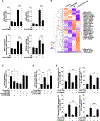Loss of TGFβ signaling increases alternative end-joining DNA repair that sensitizes to genotoxic therapies across cancer types
- PMID: 33568520
- PMCID: PMC8208885
- DOI: 10.1126/scitranslmed.abc4465
Loss of TGFβ signaling increases alternative end-joining DNA repair that sensitizes to genotoxic therapies across cancer types
Abstract
Among the pleotropic roles of transforming growth factor-β (TGFβ) signaling in cancer, its impact on genomic stability is least understood. Inhibition of TGFβ signaling increases use of alternative end joining (alt-EJ), an error-prone DNA repair process that typically functions as a "backup" pathway if double-strand break repair by homologous recombination or nonhomologous end joining is compromised. However, the consequences of this functional relationship on therapeutic vulnerability in human cancer remain unknown. Here, we show that TGFβ broadly controls the DNA damage response and suppresses alt-EJ genes that are associated with genomic instability. Mechanistically based TGFβ and alt-EJ gene expression signatures were anticorrelated in glioblastoma, squamous cell lung cancer, and serous ovarian cancer. Consistent with error-prone repair, more of the genome was altered in tumors classified as low TGFβ and high alt-EJ, and the corresponding patients had better outcomes. Pan-cancer analysis of solid neoplasms revealed that alt-EJ genes were coordinately expressed and anticorrelated with TGFβ competency in 16 of 17 cancer types tested. Moreover, regardless of cancer type, tumors classified as low TGFβ and high alt-EJ were characterized by an insertion-deletion mutation signature containing short microhomologies and were more sensitive to genotoxic therapy. Collectively, experimental studies revealed that loss or inhibition of TGFβ signaling compromises the DNA damage response, resulting in ineffective repair by alt-EJ. Translation of this mechanistic relationship into gene expression signatures identified a robust anticorrelation that predicts response to genotoxic therapies, thereby expanding the potential therapeutic scope of TGFβ biology.
Copyright © 2021 The Authors, some rights reserved; exclusive licensee American Association for the Advancement of Science. No claim to original U.S. Government Works.
Figures






Similar articles
-
Validation of Anticorrelated TGFβ Signaling and Alternative End-Joining DNA Repair Signatures that Predict Response to Genotoxic Cancer Therapy.Clin Cancer Res. 2022 Apr 1;28(7):1372-1382. doi: 10.1158/1078-0432.CCR-21-2846. Clin Cancer Res. 2022. PMID: 35022323 Free PMC article.
-
Alternative end-joining repair pathways are the ultimate backup for abrogated classical non-homologous end-joining and homologous recombination repair: Implications for the formation of chromosome translocations.Mutat Res Genet Toxicol Environ Mutagen. 2015 Nov;793:166-75. doi: 10.1016/j.mrgentox.2015.07.001. Epub 2015 Jul 4. Mutat Res Genet Toxicol Environ Mutagen. 2015. PMID: 26520387 Review.
-
DNA damage response factors from diverse pathways, including DNA crosslink repair, mediate alternative end joining.PLoS Genet. 2015 Jan 28;11(1):e1004943. doi: 10.1371/journal.pgen.1004943. eCollection 2015 Jan. PLoS Genet. 2015. PMID: 25629353 Free PMC article.
-
Subjugation of TGFβ Signaling by Human Papilloma Virus in Head and Neck Squamous Cell Carcinoma Shifts DNA Repair from Homologous Recombination to Alternative End Joining.Clin Cancer Res. 2018 Dec 1;24(23):6001-6014. doi: 10.1158/1078-0432.CCR-18-1346. Epub 2018 Aug 7. Clin Cancer Res. 2018. PMID: 30087144
-
Repair of DNA double-strand breaks by mammalian alternative end-joining pathways.J Biol Chem. 2018 Jul 6;293(27):10536-10546. doi: 10.1074/jbc.TM117.000375. Epub 2018 Mar 12. J Biol Chem. 2018. PMID: 29530982 Free PMC article. Review.
Cited by
-
Identification of Risk Loci for Radiotoxicity in Prostate Cancer by Comprehensive Genotyping of TGFB1 and TGFBR1.Cancers (Basel). 2021 Nov 8;13(21):5585. doi: 10.3390/cancers13215585. Cancers (Basel). 2021. PMID: 34771749 Free PMC article.
-
HIV-1 Vpr orchestrates ciTRAN upregulation through TGF-β induction.PLoS Pathog. 2025 Jul 9;21(7):e1013332. doi: 10.1371/journal.ppat.1013332. eCollection 2025 Jul. PLoS Pathog. 2025. PMID: 40632811 Free PMC article.
-
Transcriptome Sequencing Reveals Tgf-β-Mediated Noncoding RNA Regulatory Mechanisms Involved in DNA Damage in the 661W Photoreceptor Cell Line.Genes (Basel). 2022 Nov 17;13(11):2140. doi: 10.3390/genes13112140. Genes (Basel). 2022. PMID: 36421815 Free PMC article.
-
Beta human papillomavirus 8E6 promotes alternative end joining.Elife. 2023 Jan 24;12:e81923. doi: 10.7554/eLife.81923. Elife. 2023. PMID: 36692284 Free PMC article.
-
Proteogenomic analysis of chemo-refractory high-grade serous ovarian cancer.Cell. 2023 Aug 3;186(16):3476-3498.e35. doi: 10.1016/j.cell.2023.07.004. Cell. 2023. PMID: 37541199 Free PMC article.
References
-
- Korkut A, Zaidi S, Kanchi RS, Rao S, Gough NR, Schultz A, Li X, Lorenzi PL, Berger AC, Robertson G, Kwong LN, Datto M, Roszik J, Ling S, Ravikumar V, Manyam G, Rao A, Shelley S, Liu Y, Ju Z, Hansel D, de Velasco G, Pennathur A, Andersen JB, O’Rourke CJ, Ohshiro K, Jogunoori W, Nguyen BN, Li S, Osmanbeyoglu HU, Ajani JA, Mani SA, Houseman A, Wiznerowicz M, Chen J, Gu S, Ma W, Zhang J, Tong P, Cherniack AD, Deng C, Resar L, Weinstein JN, Mishra L, Akbani R, A pan-cancer analysis reveals high-frequency genetic alterations in mediators of signaling by the TGF-beta superfamily. Cell Syst. 7, 422–437.e427 (2018). - PMC - PubMed
-
- Glick AB, Weinberg WC, Wu IH, Quan W, Yuspa SH, Transforming growth factor β1 suppresses genomic instability independent of a G1 arrest, p53, and Rb. Cancer Res. 56, 3645–3650 (1996). - PubMed
Publication types
MeSH terms
Substances
Grants and funding
LinkOut - more resources
Full Text Sources
Other Literature Sources
Medical
Molecular Biology Databases
Research Materials

